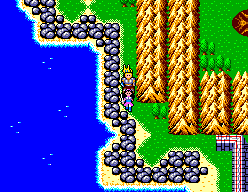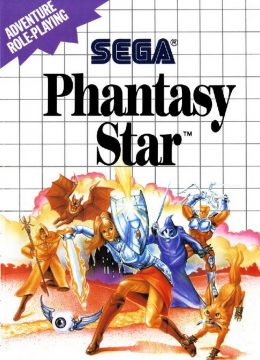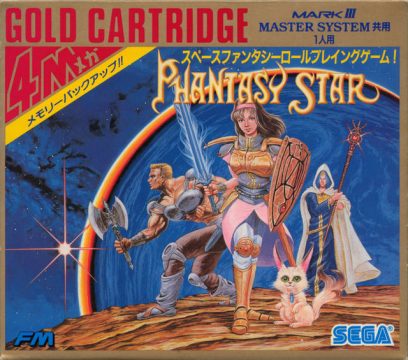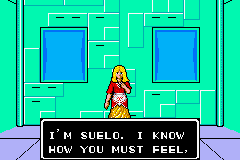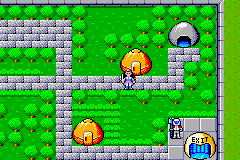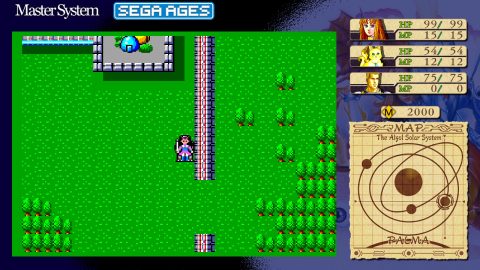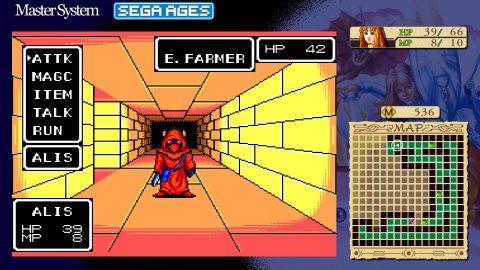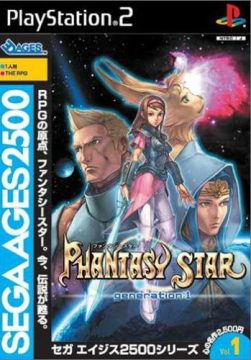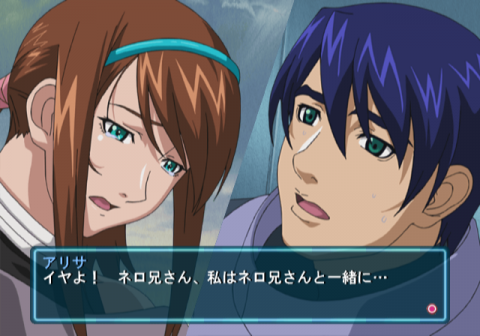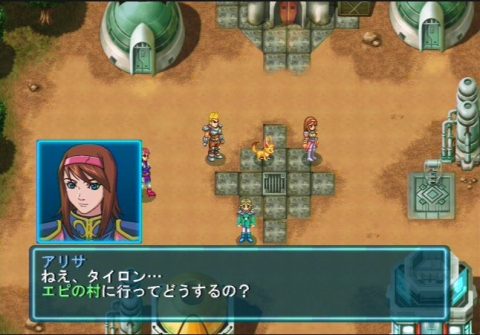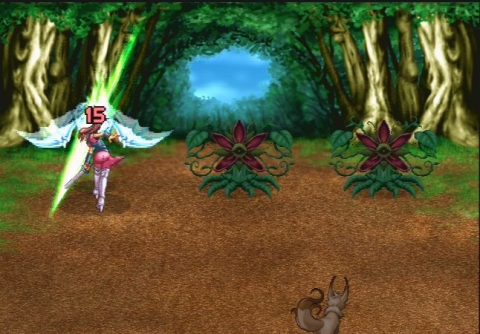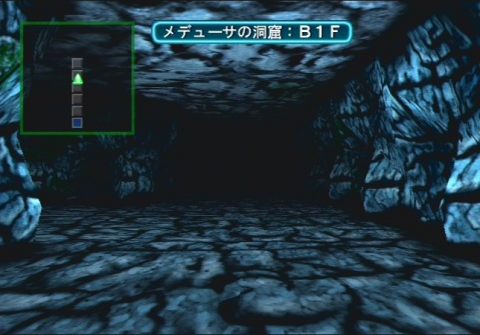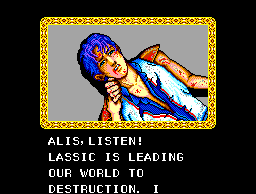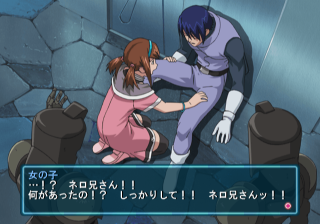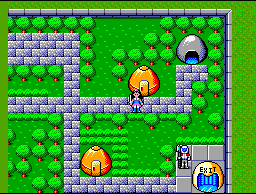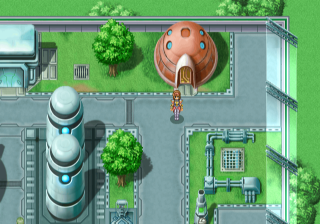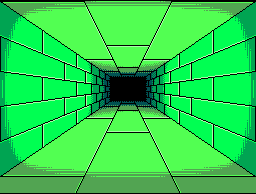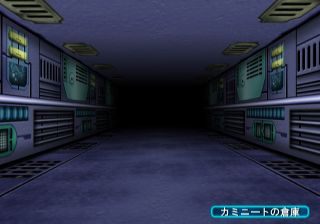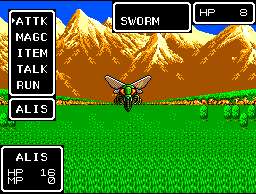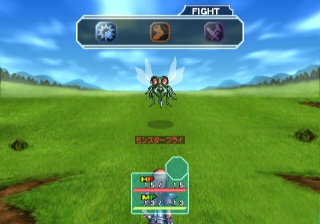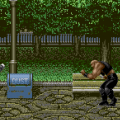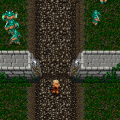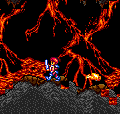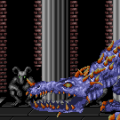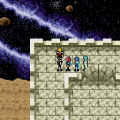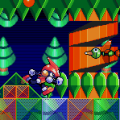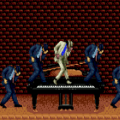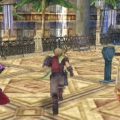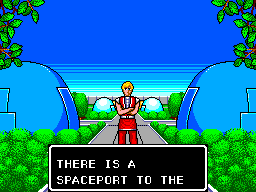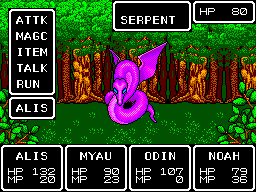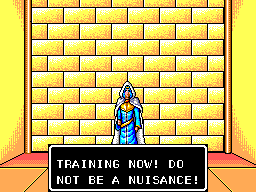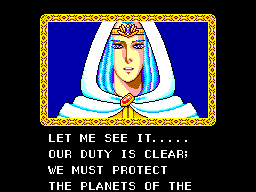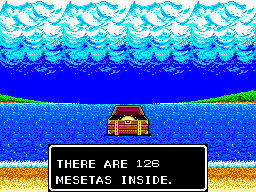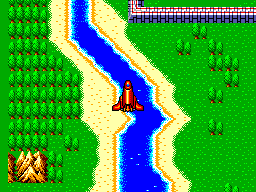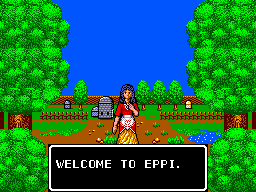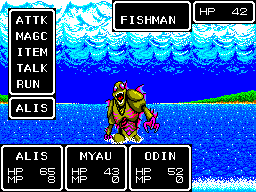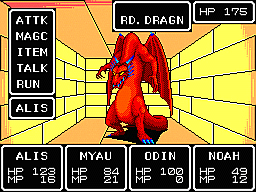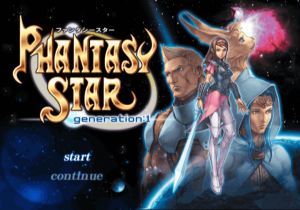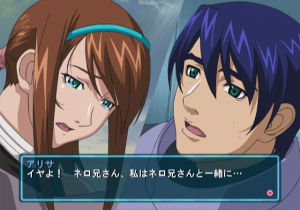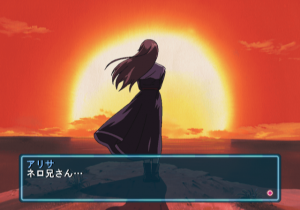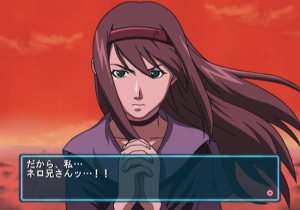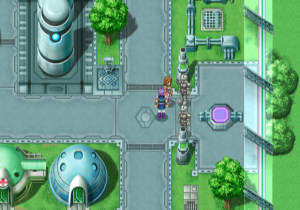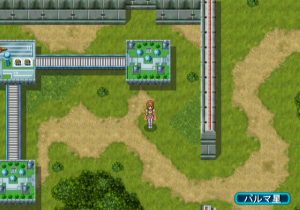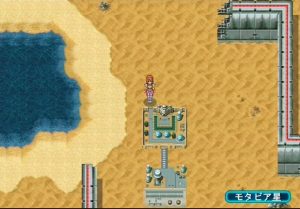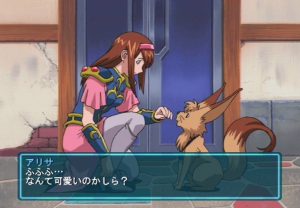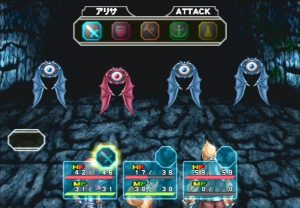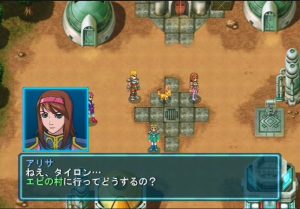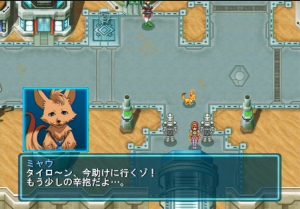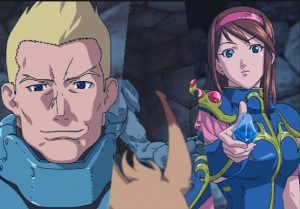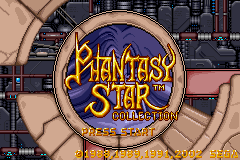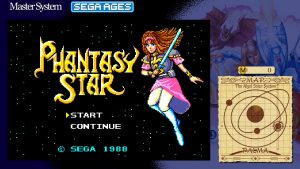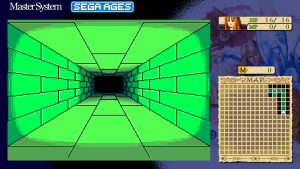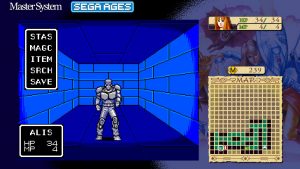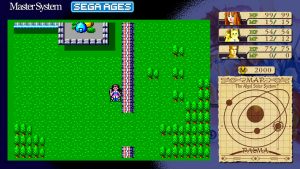Co-authored by Kurt Kalata
As the flagship turn-based RPG series for two successive consoles known for having few, Phantasy Star was a favorite of every Sega fan’s by default. But it was also much more. Where many developers were content to propose their own off-brand Dragon Quest substitute in the early years of the genre’s Japanese popularity, Sega created a series with a distinct identity, fusing science-fiction and fantasy into a rich universe whose history spans thousands of years.
The four core games take place in the Algo solar system, where three planets are inhabited by three intelligent species. Their names tend to change from game to game, a result of typically inconsistent early video game translations; there is Motavia (or Mota), the desert planet, where the short, blue-furred, and beaked Motavians live as nomads; Dezolis/Dezoris/Dezo, a cold planet inhabited by tall and lanky lizard-like humanoids; and Palm, Parm, or Parma, whose climate is most like Earth, and whose people are most like humans. As the saga begins, the Parmans have developed space age technology and colonized the other two planets. Every millennium, a being known as Dark Force returns to threaten Algo’s existence, manipulating people from the shadows like the Devil in Christianity. But as the saga’s conclusion reveals, there is more to it than simple evil.
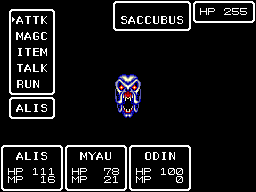
This dream sequence offers the first glimpse of Dark Force in the series.
Development on the first Phantasy Star began in late 1986 or early 1987, as RPGs were beginning to take off in Japan. The genre had been around for few years on various home computers, but Enix’s Dragon Quest, while not yet the cultural phenomenon it would become, had been a big hit, and various third parties tied to Nintendo’s Famicom were starting to get in on this new trend. Sega decided the Mark III needed RPGs of its own.
The company handled nearly all Mark III software in those days, as they had done with their first 8-bit console, the SG-1000. Employees at the R&D2 department, were console software was made, were asked to come up with ideas for a new RPG, and a woman by the name of Chieko Aoki submitted a detailed outline for what would become Phantasy Star. A team was formed, comprising some of the department’s most promising talent. The director and lead game designer was to be Kotaro Hayashida, responsible for the biggest Master System title up to that point, Alex Kidd in Miracle World, as well as soon-to-be-released fan-favorite Zillion. Artist Rieko Kodama and composer Tokuhiko Uwabo, who’d worked with him on both games, came along. Uwabo, better known as “Bo”, handled all music and sound effects, while Kodama was in charge of the character designs and graphics, with a few additional artists working under her supervision. The main programmer was future Sonic Team star Yuji Naka, already considered an exceptional talent among his colleagues. Aoki herself also contributed to the game’s design, along with a few more planners. Concurrently with Phantasy Star’s development, Sega obtained the rights to port two computer RPGs, The Black Onyx and Haja no Fuuin (Miracle Warriors), to which Kodama, Uwabo, and other members of the PS team also contributed. Another planner on Phantasy Star, Miki Morimoto, would direct the Master System port of Ys the following year, bringing the console’s library to a total of four proper RPGs during the short span of its Japanese run.
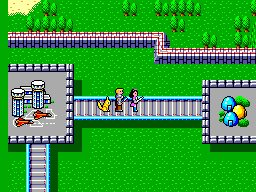
The team worked together in a small room in a tight-knit atmosphere. The guiding philosophy was to stand out in every way possible. Most other RPGs had a fantasy setting, so Phantasy Star would mix in science-fiction elements, taking Star Wars as its primary inspiration. The Famicom couldn’t handle smooth-scrolling 3D mazes, so Phantasy Star would use them. Dragon Quest II had added a ship to travel between continents, so Phantasy Star would have spaceships to travel between planets.
Hayashida had an interest for vehicles and the way they could be used in video games; he had already given Alex Kidd a motorcycle and a foot-powered helicopter to ride through his platforming levels. For Phantasy Star, he came up with three vehicles that would speed up travel and reduce enemy encounters, while each having its own unique function. The Landrover can get over antlion hills in the Motavian desert, the Hovercraft over seas and rivers, and the Icedigger is equipped with rotating spikes that can destroy blocks of ice to access remote parts of Dezoris.
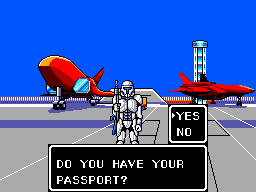
Science-fiction…
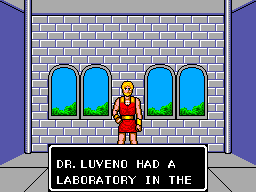
…and fantasy, with a bit of an Ancient Greece feel.
Though the decision to have a heroine lead the party likely happened organically – the original outline, after all, had been written by a woman, and there were several women in key positions on the team -, it fit in with this general theme; after all, RPGs almost always starred a young man or male teenager.
But Phantasy Star opens as the usual heroic male figure lies dying on the streets of his home town, Camineet. Things have taken a dark turn on Parmia in recent times; hordes of monsters roam the land, and King Lassic has put the entire planet under martial law. Guard robots have been posted at the exits of all the major cities, and space travel has been heavily restricted. Nero Landale (a former spaceport worker, according to the Japanese manual) has been attempting to meet up with the famous warrior Odin, who is rumored to share his goal of overthrowing the king. Before that can happen, however, he is assassinated by the authorities in broad daylight. His younger sister, Alis, witnesses his final moments and swears vengeance.
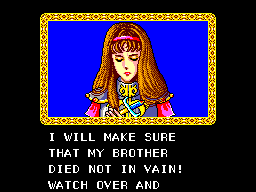
…protect me, Nero!”
This scene is portrayed through detailed illustrations that remain impressive today. There are many such large-scale illustrations throughout the game; when talking to NPCs or entering house, the game switches to a first-person view, picturing people and places through full-screen portraits. The backgrounds during battles, too, are striking, with a higher level of detail than those found in most 16-bit RPGs. Though battles are limited to one enemy type at a time, of which only one specimen is actually represented, they’re fully animated, something that wouldn’t become common for years in the genre. When walking in town or on the overworld, your party members can be seen lined up behind Alis as colorful, not-quite-super-deformed sprites. The first-person dungeons scroll and rotate smoothly, rather than the jerky step-by-step motion and instant 90-degree turns of other early first-person console games. To accommodate all this, the game was given a then-extravagant 4 megabit (or 0.5 megabyte) cartridge, four times the size of Dragon Quest II.
In Japan, an accessory called the FM-Unit, released the same year (and later integrated into Japanese Master Systems), allowed Mark III users to enjoy enhanced soundtracks with additional sound channels, bass lines and percussion effects in games programmed for it. With it, the upbeat soundtrack is much more in line with that of its Genesis sequel than with what a standard NES RPG could produce (though Konami’s Lagrange Point would integrate a special chip to similar effect in 1991). Looking at the game in action while listening to the FM soundtrack, it’s hard to believe the game was released in 1987, literally two days after Final Fantasy, and several months before Dragon Quest III.
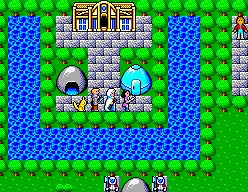
Paseo, capital of Motavia…
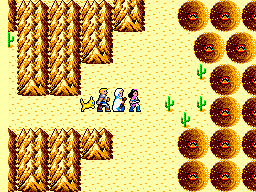
…and the desert outside, covered with antlion hills.
In its structure and narrative, however, the game is much closer to its contemporaries. You spend much of it finding the other three members of your party, then gathering various items you need on your quest, with just a handful of story scenes throughout the game. In fact, it’s a bit of a dungeon crawler; the dungeons are deep, maze-like, and some of the later ones feature trick floors and invisible doors. There are, of course, no maps, as players were expected to make their own in those days. Random encounters are frequent. Surviving them requires a lot of level grinding, particularly early on, though things ease up once your party is complete. You can actually save anywhere, though, and you get plenty of slots, which was quite practical at a time when unwieldy passwords were still common.
The game’s world is unusually vast, with three distinct planets to explore and quite a few towns along the way. In addition to the vehicles mentioned earlier, there is also an item (and later, a spell) that takes you back to the last church you’ve visited, and another to escape dungeons instantly, making travel relatively convenient.
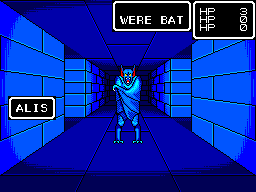
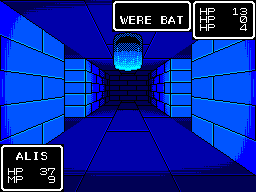
The mechanics of battle are mostly standard, but you have the option to talk to the foes you encounter – some of them, like the Motavian farmers and Dezorian peasants you encounter, aren’t necessarily hostile, and might even dispense with some useful advice. Dezorians, however, don’t always tell the truth. Actual monsters don’t speak your language, but there are spells that make communication possible. There is no way to target a particular monster within the group, making weapons and spells that attack all or several enemies especially useful.
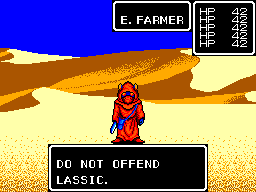
Motavians were initially based on the Ewoks from Star Wars, though their design would change a bit throughout the series.
Though they only get a bit of development, mostly in the short cutscenes that take place when you first meet them, the cast members are referred to on several occasions in later games, elevated to legendary status within the series’ universe.
Characters
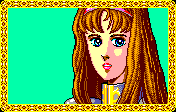 Alis – A young woman from Camineet on Palma, raised by her older brother after the death of her parents. She takes over her brother’s quest after his own death.
Alis – A young woman from Camineet on Palma, raised by her older brother after the death of her parents. She takes over her brother’s quest after his own death.
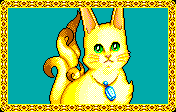
Myau – An intelligent, talking cat born of scientific experiments, Myau was traveling along with Odin, but became separated when the latter was turned to stone by Medusa, and ended up being kidnapped and sold by a greedy merchant. He can take on another form if he eats a Nut of Laerma.
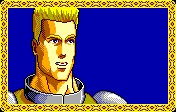
Odin – A famous warrior, he went out to slay the monstrous Medusa in order to obtain her legendary Laconian Axe, but was turned to stone. In addition to axes, he’s the only character who can handle guns, which deal a fixed amount of damage to all foes. Character designer Rieko Kodama had trouble with his design, so she asked another artist to step in. The result was clearly modeled on Arnold Schwarzenegger, as was common in those days.
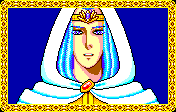
Noah – Known as Lutz in Japan – this is important for later games – this wizard is training in a cave on Motavia when the local Governor sends you to him, referring to him as a “her” in an infamous translation error. To be fair, his appearance is rather androgynous, and in fact, the developers had thought of making him a hermaphrodite during development. In the PlayStation 2 remake, he’s given the full name Mizeris Lutz Iisa Lanye.
In general, the translation wasn’t bad for its time, but some inane changes were made. Healing items became “fries” and “hamburgers”, and the drug stores that sold them turned to “first food” spots (a typo of “fast food”) – though players can still plainly see the vials filled with liquid on display. Most character names were changed. In one case, that’s understandable; Dark Falz, later known as Dark Force, was called “Dark Phallus” in Japan, though he doesn’t especially look like one. This isn’t as gratuitous as it sounds; its design takes after H.R. Giger’s art, and one of his original designs for the creature in the movie Alien had a head and lower body ending in enormous penises. More importantly, some text was cut out, probably for space reasons, which is not something an 8-bit RPG can generally afford.
A fan retranslation exists, which clarifies certain backstory details and character motivations, and also reveals a bit more personality on the protagonists’ part, such as Odin’s somewhat macho attitude during his first encounter with Alis. Because the patch is applied directly to the Japanese ROM, it also allows one to enjoy the FM soundtrack.
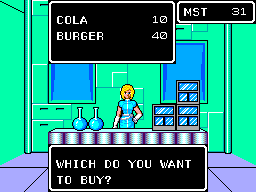
Which of these vials is the burger?
There’s also a few humorous scenarios, including one that pokes fun at early RPG conventions. At one point you need to find a bakery, in order to buy a cake to present to the Governor of Motavia as a gift. But for some reason, it’s been set up inside of a dungeon, where it very obviously doesn’t get much in the way of customers, except for the main party. In subsequent games, including Phantasy Star IV, Phantasy Star Zero, and Phantasy Star Online, there are shops called the Naura Bakery, a reference to the Naula cave from this game, which are found in hidden or remote locations.
Though something of a slog, Phantasy Star remains a classic, and a great showcase for the Master System. In North America and Europe, it was released in 1988, ahead of either Dragon Warrior and Final Fantasy; to most who got to play it then, it served as an introduction to Japanese RPGs, and retains a very special place.
It’s also been ported a number of times, typically as part of compilations, though there are few differences between these versions. The first re-release was for the Mega Drive in Japan, which was originally given away as part of a contest to promote Phantasy Star IV, but later received a small-scale retail release due to demand. This is literally just the Master System ROM in a Mega Drive casing, since the system was backwards compatible. However, as the Mega Drive doesn’t support the FM module, only PSG music is available.
The next version showed up on the Phantasy Star Collection for the Saturn in Japan in 1998, bundled with the three later games. Seeing as the Saturn doesn’t support the 256×192 resolution of the Master System, the screen is pillarboxed on the sides, and the visuals are slightly thinner. Both PSG and FM music is available though, and there are some minor tweaks, like changing the text to hiragana rather than katakana as in the original release, and an option to increase the walking speed. There’s also some supplementary galleries for the entire series.
A different Phantasy Star Collection was created exclusively for Western markets in 2002 for the Game Boy Advance, which only has the first three titles. This was developed by Digital Eclipse. There aren’t any improvements to these titles at all, unfortunately. The original Phantasy Star comes off the worst – in order to try and fit the 256×192 display onto the GBA’s 260×140 screen, it uses a technique which compresses the frame and then flickers between certain lines, in order to preserve the readability of the text. It still looks pretty good (and isn’t all that noticeable on the actual systems) but it’s still a bit squished. The music is converted relatively well, though with a bit of static, and since it’s based on the English release, it’s PSG only. However, the worst issue is that there’s a bug that may randomly crash the game when you try to save. It won’t delete your data but the new save isn’t recorded, either, so you’ll need to resume from the time you saved before that. As a result, it’s a crapshoot ever time you try to record your progress.
The Phantasy Star Complete Collection for the PS2 is another emulated version, done by M2, which includes all of the titles in the series, including the Game Gear spinoffs and Mega Drive text adventures. This includes both FM and PSG options, plus the hiragana mode and faster walking speed of the Saturn version, as well as assorted tweaks to increase experience and gold acquisition rates. The display options are comprehensive, including running the game in 240p, so when run through composite cables, it’ll look far better than the original SMS could output. This collection even includes the English ROMs, so as long as you can navigate through the menus, English speakers can play the game with all of the enhancements. However, since it’s still based on the American ROM, again FM synth is not available. This version is also available cheaply for the Japanese PSN for the PlayStation 3, so if you have a Japanese account, you can buy and play it on any region system.
The SMS Phantasy Star is a hidden title on the Sonic’s Ultimate Genesis Collection for the PlayStation 3 and Xbox 360, created for the Western market and developed by Backbone Entertainment. The Genesis titles are also included and are available from the outset, but in order to unlock Phantasy Star you need to beat the first boss of Sonic the Hedgehog 2 while playing with two players. This also requires using a second controller, so if you don’t have one for the console, you’re out of luck. This is a straight, no frills emulation of the American ROM.
The ultimate version of the SMS Phantasy Star was released on the Nintendo Switch in 2018. Ported as part of the Sega Ages line by M2, this includes both American and Japanese versions, plus allows the use of the FM synth for the English version for the first time in an official release. It includes the faster walking speed and katakana options for the Japanese version, too. By far the biggest improvement is the Ages Mode – in addition to multiplying the gold and experience gain rates (like the PS2 version), it also adds a complete guide of spells, items, and monsters.
But the best addition is an automap feature that makes navigating the dungeons so, so much easier. Since it maps one spot ahead in every direction, it does spoil the locations of traps, though it’s still easy to fall into one if you’re moving too fast. Since the game display only takes up about half of the Switch’s screen, the map is displayed separately in the upper right part of the frame.
Phantasy Star Generation: 1 – PlayStation 2 (2003)
Aside from the many modified ports, there is also a complete remake for the PlayStation 2. In 2003, Sega teamed up with D3 Publisher, known for their Simple 2000 line of budget games, to create cheap remakes of some of their classics under the Sega Ages 2500 moniker. Phantasy Star Generation: 1 was their first release. Development was handed to Japan Art Media, a company that had once created its own RPGs, such as the Aretha series on Super Famicom, but had since been reduced to contract work for other companies. Their previous release had been the mediocre GBA remake of Lunar, and their next one would be the much-reviled Lunar: Dragon Song. This being the inaugural entry of this line, it comes in a large box that includes a binder, which is used to hold the little data cards that came with many of the subsequent Sega Ages 2500 games.
The first Sega Ages game is almost entirely 2D. The art style has been revamped to put it more in line with the Phantasy Star Online titles, although the in-game cinema artwork isn’t quite as good as the cover. The game displays at 480i, making for much crisper visuals, but unsurprisingly, it looks, sounds and reads like the low-budget project it is.
The field graphics look like a bunch of tiles pasted together in some version of RPGMaker, the cutscene illustrations aren’t technically bad, but they look like something out of some generic visual novel, and the battle sprites like they were drawn by a Westerner trying to do manga. The towns are cramped and look like they’re built out of plastic. The full-screen, first-person illustrations of NPCs are gone, and the sprites’ walking animations look weird from the side. The dungeons are still first-person, although the 3D polygons look substantially worse than the scrolling from the Master System game. On the other hand, the movement is smoother, and the dungeons look different from one another this time, instead of consisting of the same palette-swapped brick patterns. In sum, the graphics were upgraded to high-resolution, but downgraded to low artistry.
The battle system now more closely resembles PS II and IV, ditching the first person perspective in favor of an over-the-back third person perspective. Lots of things have changed, including character attacks, and you can actually fight multiple enemies of the same type here. The baddies and spells now have elemental affinities, and there are new attacks involving the combination of certain expensive jewels. These can add extra elemental effects, depending on your weapon. You can also mix and match between two crystals, giving combination effects (for example, combining fire and thunder will create a spell called “Disaster”). These don’t use MP, but will break if you use them too often. Everything has been rebalanced so battles move by quicker, too. The fluid items from Phantasy Star Online have been added, to allow you to restore MP. In general, there’s much less grinding (you start with a lot of cash), and for the most part, it’s easier than the original. Another addition is the Atlas item, which displays an automap for 100 steps, making exploration a bit easier. You can now save temporarily at any point in the game, but need to use save points in towns for permanent saves.
Other elements have been borrowed from Phantasy Star IV, and sometimes improved upon – it’s much easier to equip new items, and there’s a Talk option where your party can chat among themselves regarding their next objective. Your party walks faster, there’s a little swirly effect when you get into battle instead of the screen simply fading, and NPCs actually walk around town instead of standing in place. In fact, there’s whole lot of new dialogue everywhere, creating a much more fleshed story, even though the plot is still identical. There’s also an additional sidequest to hunt down pairs of brothers and sisters that have been separated across the star system. On the downside, there are now a ton of mandatory menial fetch quests that involve talking to people in towns over and over until you’re allowed to move on – these are usually to find dungeons keys, but you need to go through some annoying (and different) steps to get the Passport, right at the beginning of the game.
The biggest issue, however, is with the soundtrack. Not all of it is bad (the dungeon tunes still sound decent), but whoever arranged the tunes completely missed the point, as the sometimes somber soundtrack of the original has been mangled into peppy, upbeat nonsense – the town theme sounds like something out of a carnival. It might still be preferable to the PSG version in spots, as it does feature the rhythm section, at least.
Much of the charm is missing from this version, though for an alternate take on Phantasy Star, it’s worth checking out, at least for a few hours, especially for the expanded dialogue. The extra fetch quests can be a pain if you don’t know Japanese, because the walkthroughs for the SMS version don’t quite correspond to this one, but a fan translation is available to put it all in English anyway.
Links & Sources –
Shmuplations – World of Phantasy Star Interview, Kotaro Hayashida Interview
Mobygames – Game credits and release dates for Phantasy Star, Black Onyx (SG-1000), Miracle Warriors (SMS) and Ys (SMS). Additional credits found in interviews above.
